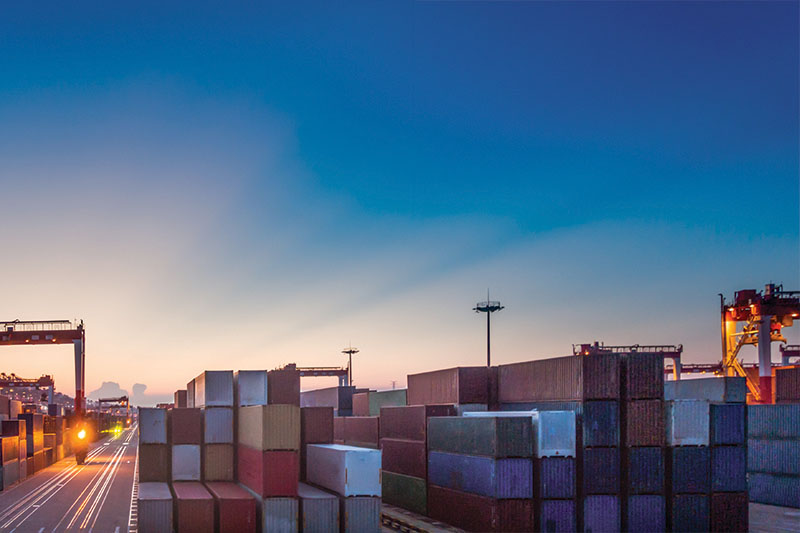Intermodal volumes slip in November, reports IANA

November intermodal volumes continued an ongoing run of declines, according to data provided to LM by the Intermodal Association of North America (IANA).
Total shipments for the month—at 1,441,181—were down 18.5% annually. Domestic containers—at 653,626—saw a 2.6% decline, while trailers—at 93,147—slumped 24.5%. All domestic equipment—at 746,773—was off 6%. ISO, or international, containers—at 694,501—saw an 11% decline.
On a year-to-date basis through November, IANA reported the following:
- domestic containers fell 4.7% to 6,975,343;
- trailers were down 14.8% to 1,123,614;
- all domestic equipment was off 6.2% to 8,098,957; and
- ISO containers slipped 1.4% to 8,638,016
These numbers are in line with how current intermodal market conditions have played out for several months, with myriad factors that have influenced intermodal throughout the year remaining intact, including loosening truck capacity putting pressure on domestic intermodal, and changes in trade policy eating away at container volumes and subsequently international traffic.
Last month, IANA reported in its quarterly “Market Trends” report that total third quarter volume––at 4,662,488––was off 3.7% annually, marking the fourth consecutive quarter of annual declines after a lengthy stretch of gains going back to the third quarter of 2016. The first quarter of 2019 was down 1.5% annually, following 4.7% and 4.2% annual gains from the third and fourth quarters of 2018, respectively. And second quarter volumes were off 3.8% annually.
In a recent interview, IANA President and CEO Joni Casey said that looser trucking capacity and less rate pressure are clearly impacting domestic intermodal.
“But there has been a slight tightening of over-the-road capacity in the last month, with related adjustments to pricing,” she said. “And carriers using AOBRDs Automatic On-Board Recording Devices have until Dec. 2019 to either modify their current systems to meet ELD specifications or transition to an ELD [the deadline was December 16], so this could serve to further tighten trucking capacity. Also predicted resolutions of trade issues would positively impact inland intermodal moves.”
When asked if the ongoing trade issues, specifically in regards to the U.S.-China trade war, will continue to impact ISO volumes, Casey said that is hard to tell, with the caveat that, at some point, the build up of inventories that occurred last year will be worked off and are going to need to be replenished.
In looking back at the first three quarters of 2019, Casey said the things, or factors, that stand out the most are increasing volatility in international shipments, accelerated declines in intermodal trailer volumes, and higher than expected capacity in the trucking segment.
Looking ahead, IANA said that should fourth quarter volumes improve, they would still be up against a difficult 2018 annual comparison, due to a pre-tariff surge at that time. And it added that other factors that could keep volumes down include significantly lower truck rates, extra truck capacity, and changes to railroads’ intermodal service.
As for 2020, IANA pointed to various factors that could bring the mode back to the right side of growth, including: potential trade deals, rising fuel prices post the IMO 2020 application, re-tightening truck capacity and railroads’ efforts to drive growth in 2020, as well as the strength of the U.S. economy, in the form of fewer trade wars and improved industrial production output.

Article Topics
Rail & Intermodal News & Resources
U.S. rail carload and intermodal volumes are mixed in April, reports AAR Q1 intermodal volumes are up for second straight quarter, reports IANA 2024 State of Freight Forwarders: What’s next is happening now STB announces adoption of final reciprocal switching rules Norfolk Southern-Ancora Holdings proxy battle accelerates Intermodal growth volume remains intact in March, reports IANA Shipment and expenditure decreases trend down, notes Cass Freight Index More Rail & IntermodalLatest in Logistics
April Services PMI contracts after 15 months of growth, reports ISM 2023 industrial big-box leasing activity heads down but remains on a steady path, notes CBRE report U.S. rail carload and intermodal volumes are mixed in April, reports AAR Q1 U.S. Bank Freight Payment Index sees shipment and spending declines S&P Global Market Intelligence’s Rogers assesses 2024 import landscape Pitt Ohio exec warns Congress to go slow on truck electrification mandates Q1 intermodal volumes are up for second straight quarter, reports IANA More LogisticsAbout the Author
Subscribe to Logistics Management Magazine

Find out what the world's most innovative companies are doing to improve productivity in their plants and distribution centers.
Start your FREE subscription today.
May 2024 Logistics Management

Latest Resources














